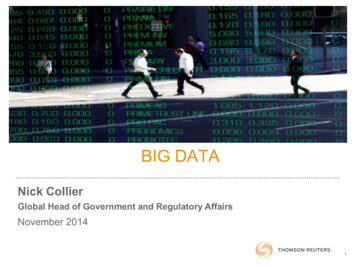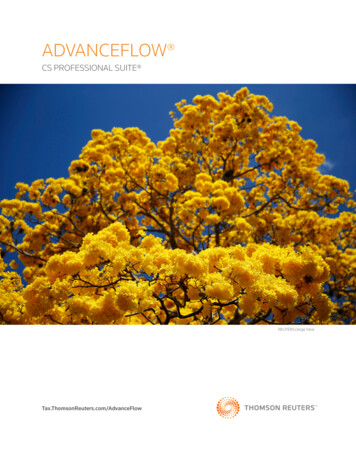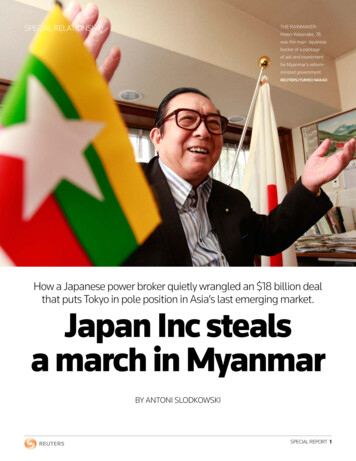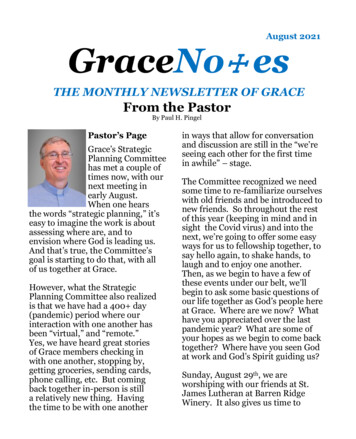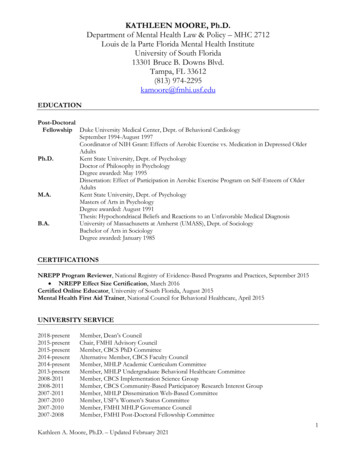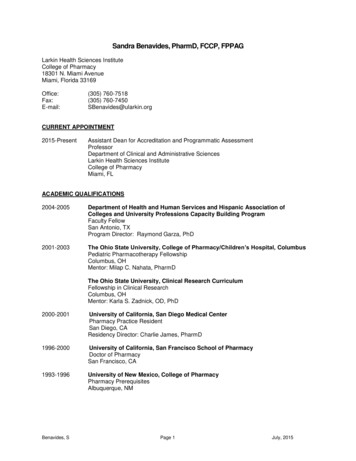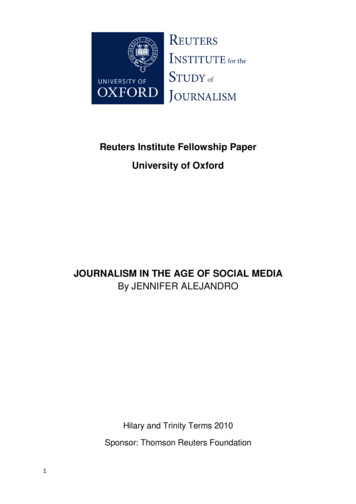
Transcription
Reuters Institute Fellowship PaperUniversity of OxfordJOURNALISM IN THE AGE OF SOCIAL MEDIABy JENNIFER ALEJANDROHilary and Trinity Terms 2010Sponsor: Thomson Reuters Foundation1
Table of ContentsIntroduction31. Mediamorphosis: Old versus New Media52. Social Media, Web 2.0 and the News93. Twitter: news media outlet of the future?184. Editors Survey: Social Media in News Operations225. Journalists Survey on Social Media286. The Future of News367. Summary and Conclusion42Bibliography44Acknowledgements462
Introduction“Social media is a term used to describe the type of media that is based on conversation and interactionbetween people online. Social media are media designed to be disseminated through social interaction, usinghighly accessible and scalable publishing techniques.” - WikipediaFor almost two decades, the web has changed the world and revolutionized how information isstored, published, searched and consumed. The ripple effect has spread so wide that it impacts notjust businesses and industries but crosses over into politics, medicine, media and breachesgeographical locations, cultural boundaries and ultimately, affects people’s day to day lives.The great wave of web innovation since Google in 1998 has been in social media. Social media isabout networking and communicating through text, video, blogs, pictures, status updates on sitessuch as Facebook, MySpace, LinkedIn or microblogs such as Twitter.What makes social media of particular interest to journalism is how it has become influential as acommunication and news-breaking tool. In June 2009, the U.S. State Department asked Twitter todelay scheduled maintenance on the service because it was being used by protestors angered by theresults of Iran's disputed presidential election. In July 2009, a Twitter user in Jakarta beat mostmajor news companies by tweeting about the Bali bombings. More recently, Google and Microsoftbegan integrating Twitter messages into their respective search engines, a new feature described asreal-time search.1This paper will attempt to answer the questions: How do social media impact the news? (Chapter 2)Is Twitter the news media outlet of the future? What is the Twitter Effect? What is TwitterJournalism (Chapters 3 to 3.2)How do social media and other web 2.0 technologies such as blogs affect newsroomoperations in reporting a news event? (Chapter 4)How social media affect the way journalists receive, gather and distribute news? (Chapter 5)What does it mean for the future of news? (Chapter 6)A survey about social media usage in news operations will be conducted among selected chiefeditors from different parts of the world: the former future media chief of the UK’s biggest newsorganization, the North American bureau chief of a wire agency, the Singapore bureau of a newswire agency, a Malaysian wire and radio news organization, an Indonesian news agency and one ofthe biggest digital online groups in India.Interviews with media experts will be part of the research including a global survey on thejournalist’s usage of social media.In this paper, I will discuss how social media and web 2.0 change the way news is gathered, reportedand consumed as well as what it means for the future of news (Chapter 6).1“2009, the year of Twitter and Facebook”, Agence France Presse, 15 December 20093
Lastly, this paper will attempt to answer the questions: Does journalism still matter? Who is thejournalist of the future? What does the newsroom of the future look like? And, what is journalism inthe age of social media? (Chapter 7)4
1. Mediamorphosis: Old versus New mediaNews consumption today is not the same as pre-satellite news when people waited for theirmorning papers or sat down at an appointed time for the evening news on television. Newsconsumption today is not the same as pre-internet news when people tune in to events happeningaround the world through 24-hour television news channels. More recently, a growing number ofreaders, viewers and listeners are going online for their news. Television, newspapers and radio arestill here but there is a growing competition from interactive online media.2This sub-chapter explores the definition of Web 2.0 and illustrates its main differences with Web 1.0.Web 2.0 allows for openness, organization and community. Web publishers are creating platformsinstead of content. Users are creating the content. Wikipedia, MySpace, Facebook and Youtube mostillustrate the power of Web 2.0 especially for ordinary web users. An approach of creating anddistributing Web content that is characterized by open communication, decentralization ofauthority, freedom to share and re-use, and the idea of “the market as a conversation” (many tomany). In comparison with the Web 1.0 model, a Web publisher (whether a news site or a personalsite) would upload content to a Web site for many others to read and the communicationtransaction would end there. The 2.0 model not only allows those “many others” to comment andadd to the content posted by the publisher, but the audience can also add original contentthemselves.3The following illustration (made by aYsoon blog for its readers) compares Web 2.0 with Web 1.0 andexplains how things have changed since the web culture has evolved. Webmaster and userinteraction no longer depend on direct means of communication but have been turned into a wholenew system of social interaction which includes really simple syndication (RSS feeds) and also theuse of social networking sites.423http://www.cbc.comM. Briggs, “Journalism 2.0: How to survive and thrive: A digital literacy guide for the information age”, J-Lab:University of Maryland, 2007, ne-seule-image5
The next illustration is a commonly used depiction of the conversation in the web today wherebyinteraction has gone social.Brian Solis, author of a book about the new web called “Engage” says the world of socialized mediais maturing and along with it, our knowledge, expertise, reach; personal and represented brands arealso flourishing. It will continue as long as we realize that these new social tools and networksrequire an entirely new commitment and embodiment of what we personify and how we can be agenuine resource to the people who define the communities that are important to us.In Technorati’s 2008 State of the Blogosphere report, the company observed that blogging isbecoming mainstream, leading the way for an Active Blogosphere – defined as the ecosystem ofinterconnected communities of bloggers and readers at the convergence of journalism andconversation. l-media-2008/6
(Illustration Source: Brian Solis and JESS3)Old media like publishing used to require a printing press. Circulation was limited to a fraction of ageographical location. Broadcasting via radio and television rely on expensive equipment to transmitsignals around a country, regionally or globally. Now, once a user connects to the internet, he hasaccess to a platform that is at once global and free. The new model assumes that the devicesthemselves are smart. This means that one may propose or explore new models of communicationand coordination without needing to get anyone’s permission. An individual with a camera or akeyboard is now a non-profit of one and self-publishing is the norm.6New-media technology is not only having a serious effect because of its impact on establishedjournalism. The way that the vast bulk of public and commercial media is changing is more importantthan the emergence of citizen journalism or the independent blogosphere. Together they offer theopportunity to transform the news media into a more open, trustworthy and useful forum forinformation and debate. As news becomes non-linear and open-sourced, journalism will change andis changing. This is about more than posting a comment on a blog or sending in a photo to a website.6C.Shirky, “ Here Comes Everybody: The Power of Organizing without Organizations”, The Penguin Press, NewYork, 2008, p.777
The claims that traditional media are the sole champions of authority, objectivity and quality will be(and is being) challenged.77C. Beckett, “SuperMedia: Saving Journalism So It Can Save The World”, Wiley-Blackwell, 20088
2. Social Media, Web 2.0 and the NewsThere is a ground shift happening in the media industry, not just in news, because of the wideningreach of social media networks. Mass media is passé. Today, it is all about personal media.In the old days, a reporter was given a lead or went out to find a story. Today, many stories arereceived third hand (sometimes even fourth or fifth hand) through Facebook posts or Tweets or Diggso that by the time a story is assigned to the reporter, the story in some form or another is alreadyout there in the social media universe. The reporter now has to take that into consideration and findsome angle to the story that is not yet being talked about.As to the notion of scoops and breaking news, a lot of tips or leads these days are from the web orwhat’s “trending” in social networks like Twitter, Facebook or its popularity rating on Digg or basedon search volume patterns in search engines like Google or Bing. This is radically changing theindustry’s concept of what a scoop or breaking news is. Journalists are forced to accelerate thetraditional journalistic process because people now want real time information. People want theinformation as soon as the journalist or the media outlet receives it. So to sit on a story until it iscomplete is to risk being out-scooped by competitors or even worse to be dubbed slow by thepublic. It is now a necessity to give the audience bits of information at a time, as soon as theinformation is available. No media outlet can afford to wait. Why? Traditionally, media outletscompete to out-scoop each other but today if they hold on to a story too long, they run the risk ofbeing out-scooped by amateurs such as bloggers, citizen journalists and twitterers.While the current technological landscape shows tremendous promise and present numerousopportunities for news and its practitioners, there are also potential pitfalls. While social medianetworks churn out viable leads, there are also a lot of hearsays going on and even hoaxes. InOctober 2008, a citizen journalist, a CNN iReport poster reported that Apple CEO Steve Jobs hadbeen rushed to the hospital after a severe heart attack citing an anonymous source. The story turnedout to be false. CNN removed the story from the site and referred to it as fraudulent. That false storyimpacted the financial markets. Apple's stock in US trade took a major hit and dived to its lowestthat year before bouncing back. Newspapers report, “the stock recovered around the time the postwas removed. Apple's stock, which opened at US 104 a share, fell by 9 percent to US 94.65 beforerebounding.”8 More recently, in late April 2010, reports surfaced on the internet that pop star LadyGaga amputated one of her legs just below the knee in the name of fashion. The story was rapidlytweeted and retweeted that eventually news media outlets took notice of the rumour. Uponverification from Lady Gaga’s record label however that the story was untrue, the story was quicklydiscredited.8R. Kim, “Apple stock dives on false report”, SFgate.com, October 20089
Social media networks such as Facebook and Twitter as well as web 2.0 applications like blogs andGoogle have changed the news industry and the journalism practice inside out. They presentawesome possibilities and at the same time a high risk for errors. The challenges social media andweb 2.0 have thrown to news managements and journalists have been like nothing seen before.Barriers to entry have been lowered since anyone with a PC, iPhone or Blackberry can be their ownpublisher. They can blog, tweet or facebook it --- anytime, anywhere.What makes social media of particular interest to journalism is how it has become influential as acommunication and news-breaking tool. In June 2009, the U.S. State Department asked Twitter todelay scheduled maintenance on the service because it was being used by protestors angered by theresults of Iran's disputed presidential election. In July 2009, a Twitter user in Indonesia beat mostmajor news companies by tweeting about the Jakarta bombings. 9CHANGING MEDIA CONSUMPTIONAs already mentioned, the consumption of news today is not the same as pre-satellite news whenpeople waited for their morning papers or sat down at an appointed time for the evening televisionnews. More and more readers, viewers and listeners are going online for their news. Television,newspapers and radio are still here but there is a growing competition.In its annual report for 2008-2009, the BBC reported that its television overall reach among the 16 to34 years old audience has fallen by over 7 percent between 2003 and 2008, from 82.6 percent to75.4 percent. The data provided by the BBC also showed the amount of BBC television viewing byteenagers have fallen from 39 minutes a day in 2003 to 24 minutes a day in 2008, a decline of nearly40 percent in a five year period.10Meantime in the United States, a 2008 study showed that 40 percent of those surveyed got most oftheir international and national news from the internet, up from 24 percent in 2007. Internetcoverage of the US presidential campaign (boosted by social media networks) was the likely reasonfor that recent growth.9“2009, the year of Twitter and Facebook”, Agence France Presse, 15 December 2009BBC Annual Report and Accounts 200910/cmselect/cmcumeds/515/51504.htm1010
(Source: Pew Research Centre for the People & the Press)Future technologies forecaster Paul Saffo says “blogging, chat groups and adding comments toonline articles are obvious examples, but they are just the beginning. In the TV era, it was hard, if notimpossible to participate, but now in the new world of personal media, the exact reverse is the case:it is hard to merely be a bystander.” 11Just this March, Facebook became the number one site in the US, overtaking industry leaderGoogle.12(Source: Hitwise US)1112P. Saffo, “Farewell Information, it’s a Media Age”, saffo.com, December 2005C.Nuttall and D.Gelles, “Facebook becomes a bigger hit than Google”, Financial Times, March 201011
So what does this tell us? That perhaps, the web is becoming more sociable than searchable orprobably both and fulfilling the internet’s promise of connecting the world.One thing is for sure, the power structures are changing. Media organisations do not have themonopoly on journalism anymore. The face of the competition is changing. In less than a decade, thelikes of Google, Facebook and Twitter are competing with the New York Times, the Guardian, CNNand BBC as the news outlet of choice. Television still leads the race for now, but for how long?SOCIAL MEDIA IS WORD OF MOUTH ON STEROIDSFor instance the news about the death of Michael Jackson in 2009, Facebook and Twitter usersbroke the story ahead of any major news network, the moment the UCLA Medical Center made thedeath announcement official. Social network sites, search engines and news websites reportedheavy traffic volumes in the hour the story broke and some websites even crashed. That single storyshowed how news is consumed and disseminated in social media, how far it can reach and how fast.In the social media sphere, news is word of mouth on steroids. It knows no boundaries.The death of Michael Jackson story is now used by media gurus as a textbook example of how socialmedia has breached the gap between traditional media and the consumers (audience). It provedthat the gatekeeper role is no longer exclusive to journalists as the participatory culture of socialmedia about engaging the audience has broken down the wall of journalism which separates thereader from the journalist. There are now known instances where news is people-driven versus theold way of just being media outlet-driven. News (information/knowledge) which was previouslydisseminated Top-down can now be disseminated Bottom-up. The audience now has a say as towhat news is important to them and as to what level of engagement they wish to pursue it whetherwatch or listen to it on TV or radio or go online or reply via mobile text or tweet about it or post it onFacebook or upload it on Youtube or if they Digg it on whatever device when they want it and wherethey want it.According to The Nielsen Company, global consumers spent more than five and a half hours onsocial networking sites like Facebook and Twitter in December 2009, an 82 percent increase fromthe same time the previous year when users were spending just over three hours on socialnetworking sites. In addition, the overall traffic to social networking sites has grown over the lastthree years.Globally, according to the Nielsen survey, social networks and blogs are the most popular onlinecategory when ranked by average time spent in December, followed by online games and instantmessaging. With 206.9 million unique visitors, Facebook was the number one global socialnetworking destination in December 2009 and 67 percent of global social media usersvisited the site during the month. Time on site for Facebook has also been on the rise, with global13users spending nearly six hours per month on the site.13Nielsen Wire 22 January 2010 sites-up-82-year-over-year/12
THE FIFTH ESTATEIf the press is the Fourth Estate, William Dutton of the Oxford Internet Institute termed social mediaas the emergence of the Fifth Estate. In a 2009 interview with Nic Newman, former BBC FutureMedia Controller, Dutton said “we are witnessing the emergence of powerful new voices andnetworks which can act independently of the traditional media. Highly networked individuals(helped by new platforms like social networking and messaging) can move across, undermine and gobeyond the boundaries of existing institutions.”14A good example of this is the case for “citizen journalists”. According to Dr. Alex Burns, a seniorlecturer in the Creative Industries faculty of Queensland University of Technology in Australia, citizenjournalists act primarily as watchdog and corrective for the mainstream. “Participants act as gatewatchers, observing and analyzing what passes through the publication gates of the journalismindustry and other official sources, and highlighting interesting and relevant news for theirindustry.”1514N.Newman, “The rise of social media and its impact on mainstream journalism”, Reuters Institute for the Study ofJournalism, Working Paper September 200915http://www.amic.org.sg/pdf/Citizen journalism.pdf13
CITIZEN JOURNALISTSOn July 7, 2005 within six hours of the London bombings, the BBC received more than 1,000photographs, 20 pieces of amateur video, 4,000 text messages and 20,000 emails. Former head ofglobal news for the BBC Richard Sambrook wrote that year, “people were participating in ourcoverage in a way we had never seen before. By the next day, our main evening TV newscast beganwith a package edited entirely from video sent in by viewers.” 16Today, the BBC has 23 journalists working in a UGC (user generated content) centre to processinformation, photos and text coming in from the general public. CNN also has a user-generatedcontent site but the branding is separate. iReport is the section of CNN.com where the stories,photos, texts and videos are uploaded by the audience.Another event that broke first through a social network was the 7.9 magnitude Sichuan earthquakein China in May 2009 which devastated the city. The BBC got wind of the China quake via Twitter.Tweets came out minutes before the US Geological Survey put up its notice.Aside from citizen journalism, there is also another developing trend called networked journalism. Itis a process of mining public knowledge to add value to the community. Charlie Beckett, author ofSuper Media describes it as “the journalist still reports, edits, packages the news. But the process iscontinually shared. The networked journalist changes from being a gatekeeper who delivers to afacilitator who connects.”Take for example the case of how the Guardian newspaper asked the British public to help trawlthrough thousands of documents and assisted in further exposing the MPs’ (Members of Parliament)expenses scandal in 2009.17 Meanwhile, the Huffington Post’s “Off the Bus” project was acollaboration with a network of citizen journalists to cover the 2008 U.S. Presidential elections onthe campaign trail. The pioneering endeavour showed a new way of gathering election newscombining input from both professional and amateur journalists and giving way to editorial diversity.While some independent citizen journalism websites that experimented on the Pro-Am(Professional-Amateur) model like Assignment Zero, a collaboration between Wired.com andNewAssignment.net have failed, there are a few citizen journalism networks that are still survivingsuch as online community newspaper Broowaha.com in the United States. But there is none moresuccessful in harnessing the potential of the open-source model or the Cit-J network than SouthKorea’s OhmyNews. OhmyNews was influential in determining the outcome of the South Koreanpresidential elections in December 2002 with the election of Roh Moo Hyun. Today, OhmyNews hasan international version with contributors from all over the world.18SOCIAL MEDIA AND THE PRACTICE OF JOURNALISMThe news industry is continuously changing and trying to keep up with web 2.0 technologies that justcame out in the past five years and the new ones that are still being rolled out. While social media16R.Sambrook, “Citizen Journalism and the BBC”, Nieman Reports, Winter .wikipedia.org/wiki/OhmyNews1714
networks and web 2.0 applications open new opportunities for the news industry, they also raise thepossibility of a professional crisis for journalists and media organisations.For the journalist, the new equation is about doing a lot more with a lot less. Reporters are nowrequired to submit stories for multiple platforms – television, radio, print and online. For a journalistin today’s media landscape, it is essential to be multi-skilled.(Source: Royston Robertson Cartoons)As for editors, there is a lot of curation going on. New posts like “social media editors” or“community editors” have been and are still being created in newsrooms since 2009.In May 2009, the New York Times hired its first social media editor to expand the use of social medianetworks and publishing platforms to improve New York Times journalism and deliver it to readers.Also early in 2009, Sky News in the UK appointed a Twitter correspondent whose main responsibilityis to cover breaking news. BBC also appointed its first social media editor in late 2009. His job is tohelp the BBC team of reporters and producers engage more proactively with social networks, Twitterbeing one of them, as newsgathering and distribution channels for journalism.19 This birth of socialmedia editors in the newsroom raises questions about the future role of editors: will they soon bedoing less journalism and more fact-checking? Will they just be relegated to copy tasting andspotting trends from social networks like Twitter, Facebook and the like?For media organisations, convergence is the common strategy. There is a growing realisation thatyou can’t do everything on your own. One media outlet cannot service all the rivers of information inthe social media sphere. Thus, partnerships abound. For example, Facebook and CNN teamed up for“Live Tweeting” during US President Barack Obama’s inauguration or BBC partnered with Adobe forstreaming video capabilities.19M.Bunz, “ What will the BBC’s new social media editor do?”, guardian.co.uk, 19 November 200915
NEWS AGGREGATORSBut another real competition for traditional media outlets is news aggregators. Many different newsaggregators exist, those run by search giants such as Google and Yahoo and those based on readerinteraction such as Digg. Google News however, also collects brief excerpts from articles on itshomepage, and makes them available via a search function. Others like huffingtonpost.com andthedailybeast.com, provide aggregation alongside original reporting and commentary.Five year old The Huffington Post is now seen as a viable threat to the more established TheWashington Post as a news and opinion site. In March 2010, Nielsen attributes more than 13 millionunique visitors to the Huffington site.20 That’s a 13 percent increase month over month and 94percent year over year, landing in the top 10 news sites for March. The New York Times was rankedsixth, while The Washington Post did not even make it to the top ten rankings. But whetherHuffington Post can translate that web traffic to revenue is still work in progress.Not everyone however, accepts the ground shift. Rupert Murdoch has accused news aggregatorsincluding search engines of exploiting the internet.21 He wants paywalls for his newspapers’ websitesand dismissed critics’ fears about consumers who are used to getting their content for free not beingprepared to pay for it. Murdoch believes the internet can’t take stories for nothing and thatconsumers can be made to change their consumption habits. He was quoted as saying “When they(consumers) have got nowhere else to go, they will start paying.”From June 2010, the content on the online sites of The Wall Street Journal and UK’s The Times andSunday Times was no longer free. Whether this business model will work or not, remains to be seen.Traditionally however, financial websites are more likely able to charge for niche and marketsensitive information and be profitable. Yearly subscription revenue from the website of theFinancial Times for example, (FT.com) rose 43 percent year on year in 2009. FT chief executive JohnRidding acknowledges that there are differences between print and online news. FT does not havean immediate paywall. The site allows users some free stories before being asked to pay for content.He says “the nature of and consumption of journalism (on the web) is different to newspapers.People come in for one story. You hope they will become a registered user or a subscriber. They maynot all become subscribers.” 22The news industry is in a period of transformation where an old media system is disappearing and anew media system is budding. An age where the passive-watcher culture is giving way to aparticipatory culture and where a society previously hooked on traditional media is giving way to amuch more complicated media landscape where the ordinary citizen has the ability to control mediatechnologies and tell their own stories in powerful, innovative and creative ways. This is an erawhere our social, cultural and technological ways of life intersect.Henry Jenkins, Director of Comparative Media Studies at MIT says the essence of convergenceculture is the audience has the power to respond, innovate, experiment and re-contextualize mediain new ways. “Convergence culture is a world where every story, every sound, every brand, imageand relationship plays itself out across a number of media channels. Collective intelligence or the20G. Reagan, “How the Huffington Post’s traffic is killing rival news sites”, Business Insider.com, April 2010P. Harris “ Rupert Murdoch defiant: I’ll stop Google from taking our news for nothing” Guardian, April 201022S.Busfield, “FT.com subscription revenue up 43%”, Guardian.co.uk, 4 March 20102116
group as a whole can put together knowledge in a more complex way than an individual is capable ofdoing.” 2323H. Jenkins “Convergence Culture: where old and new media collide” New York University Press, 200617
3. Twitter: news media outlet of the future?Four researchers from the Korea Advanced Institute of Science and Technology’s Department ofComputer Science have performed a multi-part analysis of Twitter and how it works. The groupwanted to find out whether Twitter is just a social network or a news media outlet by itself?Haewoon Kwak and his associates Changhyun Lee, Hosung Park, and Sue Moon built an array oftwenty personal computers to trawl the entire contents of Twitter for a period of one month, July2009.This author interviewed Haewoon Kwak and he said based on their empirical findings, Twitterredefines and to some extent enlarges the definition of news media.According to Kwak and his team, the role of traditional news media is played by traditional newsaccounts in Twitter. Moreover, based on their findings, these news accounts are more powerful thantraditional news media and the reasons are two-fold:24One is motivation. Some studies report that different motives lead to different levels of attentionand show that motivation to gain information for personal or social use leads to greater cognitiveinvolvement.A Twitter user actively follows others and subscribes to their tweets. Also, they can stopsubscribing to tweets whenever they want to do so. In other words, Twitter users themselvesactively choose and subscribe to their favourite news sources and the motivation to read tweetssuch as gaining information or entertainment is stronger than just passing time.The other is the form of news. The study argues that for politically inattentive citizens, soft news ismore effective than traditional news. Both a short message (tweet) and social interaction (retweet)among users puts Twitter ahead of other sources of news. Thus, Twitter can be an effective mediumto disseminate political messages.From these two observations, Kwak et al think that news accounts in Twitter can have more powerthan traditional news media.As shown in the figure below (a Retweet Tree Analysis of tweets during the Air France plane crash inJuly 20
1. Mediamorphosis: Old versus New Media 5 2. Social Media, Web 2.0 and the News 9 3. Twitter: news media outlet of the future? 18 4. Editors Survey: Social Media in News Operations 22 5. Journalists Survey on Social Media 28 6. The Future of News 36 7. Summary and Conclusion 42



